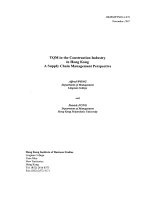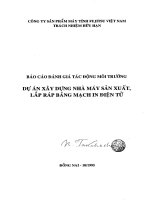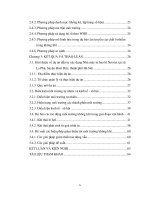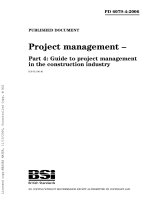Dự toán xây dựng estimating in the construction industry, dự toán lắp dựng nhà gỗ
Bạn đang xem bản rút gọn của tài liệu. Xem và tải ngay bản đầy đủ của tài liệu tại đây (7.11 MB, 203 trang )
•
Measuring Carpentry Work
•
Module 15
Module 15:
Measuring Rough Carpentry Work
Learning Outcome:
•
Prepare a takeoff for rough carpentry work.
Learning Objectives:
1. Define board measure units.
2. Measure quantities of lumber in board measure units.
3. Describe how wood framed floor systems and wall systems are measured.
4. Describe how wood framed roof systems including wood trusses are measured.
5. Describe how rough hardware is measured. ( 1 Pcs)
6. Prepare a takeoff for rough carpentry and hardware for a house in accordance with rules of
measurement and requirements of presentation.
© 2016, Southern Alberta Institute of Technology
Measuring Rough Carpentry Work
• In order to assess
rough carpentry
requirements, the
estimator has to be
familiar with framing
methods and be aware
of design requirements.
© 2016, Southern Alberta Institute of Technology
Board Measure
• The unit of measurement of lumber (metric system) linear metre. However, with the
English system, the unit is generally Board Measure (BM), Board Foot (BF). BUT first
measured in LF then converted to BF for pricing.
• 1,000-Board Feet = MBF
• Board Measure = cubic measure where one unit of BM is equivalent to 1 x 12 (Nominal
Size) board 1-foot long.
• To calculate the BM of lumber multiply the length in feet by the nominal width and
thickness of the pieces in inches and divide the product by 12.
• Pieces less than 1-inch thick are calculated using a thickness of one full inch.
© 2016, Southern Alberta Institute of Technology
Board Measure
We always use nominal dimensions
To calculate board measure or board foot
One Board Foot =
ắ
1 inch
12 inch
11 ẳ
Note .
Actual cross section dimensions of this
board are ắ inch x 11 ẳ
â 2016, Southern Alberta Institute of Technology
The length is always
expressed as the actual
length
Board Measure
Nominal
Dressed
1x2
ắ x1ẵ
1x4
ắ x3ẵ
1x3
ắ x2ẵ
2x4
1ẵx3ẵ
2x8
1ẵx7ẳ
2x6
2 x 10
1ẵx5ẵ
1ẵx9ẳ
2 x 12
1 ẵ x 11 ẳ
3x3
2ẵx2ẵ
2 x 14
4x4
6x6
1 ẵ x 13 ẳ
3ẵx3ẵ
5ẵ x 5ẵ
â 2016, Southern Alberta Institute of Technology
Board Measure
1. 14 pieces of 4 x 12
16 ft long
14 x 4 x 12 x 16 x 1/12 = 896 BM
2. 20 pieces of 3 x 10
22 ft long
20 x 3 x 10 x 22 x 1/12 = 1100 BM
3. 19 pieces of 2 x 14
20 ft long
19 x 2 x 14 x 20 x 1/12 = 887 BM
4. 120 pieces of 2 x 4
8 ft long
120 x 2 x 4 x 8 x 1/12 = 640 BM
5. 60 pieces of ¾ x 3
12 ft long
60 x ¾ x 3 x 12 x 1/12 = 180 BM
© 2016, Southern Alberta Institute of Technology
Rough carpentry work – Measuring Notes
1. Lumber is measured in linear metres or board measure.
2. Lumber generally shall be differentiated and measured separately on the basis of:
dimensions, dressing, grade and species, etc.
3. Lumber required to have special treatment (e.g., pressure treated), must be kept separate
and described.
4. Wall boards shall be measured in square metres (or square feet).
5. No deductions are made for openings less than 4 square metres. (DDT Limit 4 m2)
6. Wall boards are classified and measured separately, in type of material and thickness.
© 2016, Southern Alberta Institute of Technology
Rough Carpentry Work – Measuring Notes
1. Lumber is measured in linear metres or board measure.
2. Lumber generally shall be differentiated and measured separately on the
basis of: dimensions, dressing, grade and species, etc.
3. Lumber required to have special treatment (e.g., pressure treated), must
be kept separate and described.
4. Wall boards shall be measured in square metres (or square feet).
5. No deductions are made for openings less than 4 square metres. (DDT
Limit 4 m2)
6. Wall boards are classified and measured separately, in type of material
and thickness.
© 2016, Southern Alberta Institute of Technology
Rough Carpentry Work – Measuring Notes
Framing Work:
Lumber for framing is classified and measured separately in the following
categories:
a) Plates
b) Studs
c) Joists
d) Bridging
e) Lintels
f) Solid beams
g) Built-up beam
h) Rafters
i) Ridges
j) Hip and valley rafters
k) Lookouts and overhangs (Eaves)
l) Gussets and scabs
m) Purlins
n) Other framing items not listed
© 2016, Southern Alberta Institute of Technology
Rough Carpentry Takeoff …. Floor System
• Steel Posts
• Built up Beam or Parallam/Microlam beam or 2 x 10 ,12
• Floor Joists … Divide width of the floor by 400mm round up
then add one, also add one on each side of the stairwell
• Floor system is completed with a rim joist around the perimeter
of the house
• Floor Sheathing … Deduct any openings greater than 4 m2
© 2016, Southern Alberta Institute of Technology
Rough Carpentry Takeoff …. Floor System
© 2016, Southern Alberta Institute of Technology
Rough Carpentry Takeoff …. Floor System
© 2016, Southern Alberta Institute of Technology
Rough Carpentry Takeoff …. Floor System
© 2016, Southern Alberta Institute of Technology
Rough Carpentry Takeoff …. Floor System
© 2016, Southern Alberta Institute of Technology
Rough Carpentry Takeoff …. Floor System
© 2016, Southern Alberta Institute of Technology
Rough Carpentry Takeoff …. Exterior Walls
• Exterior walls … Perimeter length
• Plates x 3
• Studs /.4
• Add the extra studs …. WIDEC
• Lintels or headers greater than 600 mm,2ply ( 38 x 235 )
length of lintel = RO + 2 x 38 mm for 2 trimmers
• Exterior wall sheathing …. We do not deduct for windows and
door openings
© 2016, Southern Alberta Institute of Technology
Rough Carpentry Takeoff …. Exterior Walls
© 2016, Southern Alberta Institute of Technology
Rough Carpentry Takeoff …. Exterior Walls
© 2016, Southern Alberta Institute of Technology
Rough Carpentry Takeoff …. Exterior Walls
© 2016, Southern Alberta Institute of Technology
Measuring Extra Studs - WIDEC
W
I
D
E
C
4
2
2
1
2
WIDEC is a memory tool used for counting the extra studs required during
framing.
◦ Windows – 4 Extra Studs
◦ Intersections – 2 Extra Studs (In the Wall with the larger
studs)
◦ Doors – 2 Extra Studs
◦ Ends – 1 Extra Stud (interior walls only)
◦ Corners – 2 Extra Studs
© 2016, Southern Alberta Institute of Technology
Rough Carpentry Takeoff …. Interior Walls
• Interior walls … each wall one at a time …. Use highlighters
to keep track of your takeoff
• Plates x 3
• Plates for partitions are measured through door openings
• A quick way to takeoff the studs for interior partitions is to allow
a Studs for every 300mm
© 2016, Southern Alberta Institute of Technology
Roof Framing
© 2016, Southern Alberta Institute of Technology
Roof Framing
© 2016, Southern Alberta Institute of Technology
Floor Framing
© 2016, Southern Alberta Institute of Technology









